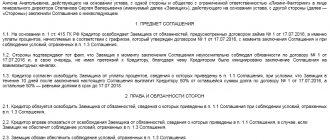How to correctly reflect debt on loans and credits in the balance sheet
According to PBU 4/99, in the balance sheet, liabilities must be presented divided into short-term and long-term depending on the maturity date:
— liabilities are presented as short-term if their maturity is no more than 12 months after the reporting date;
— liabilities are presented as long-term if their maturity is more than 12 months after the reporting date.
This should be taken into account when disclosing information in financial statements about debt:
a) for long-term loans and credits, the repayment period for which occurs no more than 12 months after the reporting date;
b) on interest due on received credits (loans). At the same time, interest payable on long-term credits (loans) due at the end of the reporting period, reflected in the balance sheet as short-term liabilities, must be separated from data on short-term loans and borrowings (see letter of the Ministry of Finance of the Russian Federation dated January 24, 2011 No. 07-02- 18/01).
For example, an organization received funds on March 25, 2010 in the amount of 3 million rubles. under a loan agreement with a repayment period in 2 years (in March 2012) at 15% per annum. Interest under the agreement is paid monthly for the period from the 25th day of the previous month to the 24th day of the current month.
When receiving a loan, the following entry was made in the organization’s accounting records:
Debit 51 Credit 67, subaccount “Loans received, principal debt” - 3,000,000 rubles.
On December 31, 2010, interest was accrued for the period December 25-31:
Debit 91-2 Credit 67, subaccount “Loans received, interest” - 8,630.14 rubles. (3,000,000 x 15% x 7 days / 365 days).
This interest is subject to transfer to the lender in January 2011, that is, in less than 12 months, therefore, in the balance sheet for 2010, the amount of the principal debt was reflected as part of long-term liabilities (section IV of the balance sheet), and the amount of interest - as part of short-term liabilities (section V balance).
In the balance sheet for 2011 as of 12/31/2011, both the amount of the principal debt and the amount of interest for the period 12/25/2011-12/31/2011 are reflected as part of short-term liabilities, since less than 3 months remained until the loan was repaid under the terms of the agreement, and until Interest payment period is less than 1 month after the reporting date.
Below is a fragment of the balance sheet for 2011:
| Indicator name | As of 12/31/2011 | As of 12/31/2010 | As of 12/31/2009 |
| IV. LONG TERM DUTIES Borrowed funds | — | 3 000 | — |
| V. SHORT-TERM LIABILITIES Borrowed funds | 3 009 | 9 | — |
| incl. interest on long-term borrowed funds | — | 9 | — |
Forward - to IFRS,
The organizations did not have time to report for 2009, but the deadline for submitting financial statements for the first quarter of 2010 has already passed.
One of the problems that arose in 2009 is the procedure for reflecting borrowed funds in accounting.
According to clause 2 of the Accounting Regulations “Accounting for expenses on loans and credits” (PBU 15/2008), approved by order of the Ministry of Finance of Russia dated 06.10. 2008 N 107n, “the principal amount of the obligation for the loan (credit) received is reflected in the accounting records of the borrowing organization as accounts payable in accordance with the terms of the loan agreement (credit agreement) in the amount specified in the agreement.”
This formulation has enabled some experts to conclude that accounts payable for loans starting from 2009 should be shown not in the amount actually received by the borrower, but in the loan amount that appears directly in the agreement. For example, if a credit line is opened for 1,000,000,000 US dollars for a period of two years, then it is the amount of the agreement that should be shown in detail on the balance sheet in ruble valuation of 30,000,000,0000 rubles! In this case, the following “logical” chain of reasoning is given in support:
— the conclusion of a loan agreement gives rise to the lender’s obligation to transfer funds to the borrower, which, in turn, gives the borrower the right to demand the lender fulfill the agreement in full;
- therefore, the borrowing organization's debts on loans (credits) in terms of lost funds are reflected in accounting and reporting as accounts payable.
However, in paragraph 2 of PBU 15/2008 we are still talking about a loan received, which is reflected in the accounting entry: Dt 51 - Kt 66 (67).
Reflecting actual uncollected loan amounts as accounts payable contradicts:
- firstly, the norms of civil law;
- secondly, the basics of accounting.
In addition, reflecting unrealistic debt in accounting can become another tool for fraudsters for the purpose of hostile takeovers and seizure of property. After all, the creation of fictitious accounts payable has always been a fraudulent technique (see the resolution of the Federal Antimonopoly Service of the Central District dated March 13, 2009 in case No. A35-2388/08-C12).
So what should accountants do? Let's first understand the legal nature of loans and credit.
According to paragraph 1 of Art. 807 of the Civil Code of the Russian Federation, under a loan agreement, one party (the lender) transfers into the ownership of the other party (borrower) money or other things determined by generic characteristics, and the borrower undertakes to return to the lender the same amount of money (loan amount) or an equal number of other things received by him of the same kind and quality. The loan agreement is considered concluded from the moment of transfer of money or other things, i.e. The loan agreement is a real contract.
If the money or things provided for in the agreement were not actually received by the borrower, the loan agreement is considered not concluded; if money or things are actually received by the borrower in a smaller quantity than specified in the contract, the contract is considered concluded for this amount of money or things (clause 3 of Article 812 of the Civil Code of the Russian Federation).
Therefore, under a real loan agreement, the only possible entry is the following:
Dt 51 - Kt 66 (67).
If there is no actual receipt of property by debit, then there cannot be any accounts payable! And the existing accounts payable reflects the real debt for the loan actually received!
There are two points of view regarding the loan agreement:
- the loan agreement is consensual - comes into force from the moment of signing (for example, resolution of the Federal Antimonopoly Service of the Central District dated April 26, 2001 N A14-7095-00/121/5);
- the loan agreement is real - it comes into force only from the moment the money is transferred (for example, resolution of the Federal Antimonopoly Service of the West Siberian District dated January 17, 2005 N F04-6973/2004 (7684-A75-21).
Supporters of the consensual nature of the loan agreement refer to clause 1 of Art. 818 of the Civil Code of the Russian Federation: “under a loan agreement, a bank or other credit organization (lender) undertakes to provide funds (loan) to the borrower in the amount and on the terms stipulated by the agreement...”. Since “obliges”, it means that the loan agreement is consensual, i.e. from the moment the agreement is signed, the borrower has the right of claim against the bank, the amount of which is reflected in the debit of account 76!
Supporters of the reality of the loan agreement cite Art. 821 of the Civil Code of the Russian Federation, which allows the lender to refuse to provide a loan to the borrower. The reality of the loan agreement is also supported by the fact that the borrower does not have the right to make a demand to force the bank to issue a loan.
In other words, for the uncollected amount of the loan and credit, accounts payable is unrealistic, i.e. fictitious, just as the corresponding receivables are fictitious (since there is no legal right of claim).
If the receivables were real, then they would be part of the organization’s property and could be assigned under an assignment or factoring agreement as a right of claim, but what real right of claim are we talking about in this case?
Now let’s move on to accounting itself, which should reflect the real financial condition of the organization.
Will accounts payable be real only on the basis of a signed loan agreement, which provides for the provision of this amount in several tranches over several years? This will simply “inflate” the balance: Dt 76 - Kt 66 (67).
And in this case:
— accounts payable is something that the organization does not owe to anyone;
- accounts receivable - something that the organization does not have the right to demand!
Thus, in our opinion, the accountant (having his professional judgment) should be guided by the following:
— the loan is considered granted and the loan agreement concluded at the time of transfer to the borrower and for the amount of funds or other property transferred to the borrower that are the subject of the loan agreement (but not earlier than the moment the agreement is signed by both parties);
— if there were several such transfers (in tranches), then all transfers are considered as an increase in the amount of the loan provided.
Otherwise, although there is a thoughtless execution of the literal text of clause 2 of PBU 15/2008, the immutable principles of accounting established by the Federal Law of the Russian Federation of November 21, 1996 N 129-FZ “On Accounting” are violated.
This is precisely the conclusion that the Ministry of Finance of Russia came to in letter dated January 28, 2010 N 07-02-18/01: in the accounting and balance sheet of the borrowing organization, liabilities are reflected as accounts payable in the amount of actual funds received under the loan agreement (credit agreement) and not repaid at the reporting date.
www.palata-nk.ru
How to reflect long-term loans and borrowings on the balance sheet (line)
Interest liabilities accrued on loans received are reflected in the balance sheet depending on the nature of the agreement.
In the process of carrying out economic activities, an enterprise or individual entrepreneur uses the labor of hired workers.
But here it is necessary to take into account that the balance of account 67 “Long-term loans and borrowings” can be transferred in whole or in part to line 1410. This is possible if, as of the reporting date, account 67 contains liabilities whose maturity as of that date does not exceed 12 months.
In this case, credits (loans) received for a period of more than 12 months are taken into account as part of long-term debt until the expiration of the specified period.
To ensure the quality of materials and protect the copyright of the editors, many articles on our website are in closed access.
The group of items “Accounts payable” (line 620) reflects the total amount of accounts payable and includes the following breakdowns:
- the article “Suppliers and contractors” (line 621) shows the amount of debt to suppliers and contractors for received goods and materials, work, and services. The amount on line 621 is equal to the credit balance on accounts with suppliers - 60 and other creditors - 76;
- the article “Debt to the organization’s personnel” (line 622) shows accrued but not yet paid wages. The amount on line 622 is equal to the credit balance on account 70.
- The article “Debt to state extra-budgetary funds” (line 623) includes the amount of contributions to state social insurance, pensions and health insurance for the organization’s employees, as well as to the employment fund. The amount on line 623 is equal to the balance on account 69, with the exception of amounts under the Unified Social Tax (which are taken into account in line 624, since they relate to debt to the budget), if it is accounted for in this account;
- The article “Debt on taxes and fees” (line 624) reflects the organization’s debt to the budget on taxes and fees. If penalties and/or fines are accrued for these taxes and fees, then the amounts of penalties and fines are also included in this article. The amount on line 624 is equal to the balance on accounts 68 and 69 (in terms of the unified social tax, if it is taken into account in this account).
- The article “Other creditors” (line 625) shows the organization’s debt for settlements, data on which is not reflected in other articles of the “Accounts payable” group. In particular, this article may reflect the organization’s debt on payments for compulsory and voluntary insurance of the organization’s property and employees and other types of insurance; debt on contributions to extra-budgetary and other special funds (except for funds, debt on contributions to which is reflected under the article “Debt to state extra-budgetary funds”); the amount of rental obligations of the rental organization for fixed assets transferred to it under long-term lease terms, etc. The amount on line 625 can be the sum of the balances on accounts 62 (advances received), 76 (except for amounts reflected in other lines of the balance sheet), 71, 73. According to the general rules for preparing financial statements, significant indicators must be disclosed separately, i.e. either highlighted as a separate line or reflected in the notes to the balance sheet. This applies, in particular, to the amounts of advances received. If these amounts are significant, then they should be reflected in a separate line of the balance sheet as a breakdown of accounts payable.
Short-term loans and borrowings in accordance with the Chart of Accounts and the Instructions for its application are reflected in account 66 “Settlements for short-term loans and borrowings” (Order of the Ministry of Finance dated October 31, 2000 No. 94n). Therefore, we can say that the balance of short-term loans and borrowings, i.e. the credit balance of account 66 as of the reporting date, should be reflected on line 1410.
Any organization, at different stages of its development, may feel the need for additional funding. And quite often the amounts of borrowed funds are quite significant.
In addition, you can select separate sub-accounts for accounting for loans, separate ones for accounting for loans, as well as for analytical accounting of loans and borrowings received in foreign currency. Each organization develops a specific list of subaccounts “for itself.”
In this case, the company pays the lender not interest, but a discount, that is, the difference between the nominal and real value of the security.
It is worth considering that when creating lines with data on loans, you must indicate not only the amount itself, but also the interest that accrues on these payments.
A loan is issued for the purpose of generating income for the lender, that is, at monetary interest. Loans can be interest-free. There is no benefit for a lender to risk their money without even receiving additional income.
It is worth considering that when creating lines with data on loans, you must indicate not only the amount itself, but also the interest that accrues on these payments.
In this article, we will learn how to calculate the remaining principal amount of a debt that needs to be repaid after a given number of periods (as well as the amount of principal that was paid in the interval between two periods).
How to convert long-term debt into short-term debt
VAT amounts deducted from advance payments should not be reflected in liabilities, since this leads to a decrease in the total amount in the balance sheet. The credit balance should be shown in the debit account. 76 AB (section where current assets are recorded).
There is too much accounting news and too little time to search for it. We recommend subscribing to the Glavbukh magazine newsletter to keep track of all changes in the work of accountants.
Credit and borrowing funds, plus interest accrued on them and other expenses that are necessary to service them (for example, this includes payment for services for obtaining consultations or conducting an examination).
The above lines 1410 and 1510 of the balance sheet are included in long-term and short-term liabilities, respectively.
One of the main characteristics of such transactions is the attraction period. Which lines in Form 1 “Balance Sheet” indicate long-term loans, and which ones indicate short-term loans? Where should I enter information about accrued interest? More on this later. How to reflect long-term loans and borrowings on the balance sheet (line) Such liabilities include funds raised for a period of more than 1 year.
The general procedure for conducting an inventory of property and liabilities is established by the Methodological Instructions. The inventory of settlements with employees consists of several stages (see diagram below).
Many enterprises face a shortage of funds in the course of their business activities.
However, the provisions of the law have some differences depending on whether the loan obligation is a credit or a loan.
Transfer of short-term loans to long-term ones
Such funds serve enterprises as financial support in times of crisis or other situations when their capital is insufficient.
As with long-term loans and borrowings, when accounting for short-term loans and borrowings, interest on loans and borrowings, as well as loans and borrowings obtained by placing bonds, are accounted for separately.
In the process of labor relations, the enterprise must accrue and pay wages to each employee of the organization, according to the regular salary. In addition, the company pays other types of payments:
- vacation pay;
- sick leave;
- financial assistance;
- compensation payments;
- awards, etc.
The notes to the financial statements must disclose information on the amounts of short-term loans and borrowings received and repaid, as well as accrued and paid interest on them for the reporting period, para.
In addition to the main body of the loan, interest on the loan, which is the income of the lender, is taken into account in separate subaccounts 66 and 67 of the account.
The liability on accounts 66 and 67 is accounted for in two ways: According to the actual amount of the loan plus interest. At par value of debt securities. What to do with interest on loans In addition to the main body of the loan, interest on the loan, which is the income of the lender, is taken into account in separate subaccounts 66 and 67 of the account.
In accounting, interest for using a credit (loan) is reflected:
- as other expenses (account 91)
- as an increase in the value of an investment asset (account 08).
Kol_per is a required argument (kol_per is the nper argument in other annuity functions, for example in PMT()). Total number of payment periods.
Debt on account 66 is reflected taking into account interest payable on loans and borrowings received.
Which line of the balance sheet should reflect accrued interest on a long-term loan, the payment period of which is less than 12 months as of the reporting date?
Such obligations include funds raised for a period of more than 1 year. Long-term loans are reflected on page 1410 of Form 1. Data from account 67 is used to fill out, or more precisely, the amount of the credit balance on the account at the end of the year is indicated. The same line also reflects interest accrued in accordance with the contractual terms.
Signs of short-term liabilities
The second method is used if the purpose of obtaining a credit (loan) is the acquisition (construction, production) of an investment asset.
The minus sign indicates different directions of cash flows + (loan amount from the bank), - (monthly payments to the bank). For example, a company has a long-term loan for 5 years in the amount of 5,000,000 rubles with an annual interest rate of 12.1%, received in April 2017. According to the terms of the agreement, interest is paid monthly.









